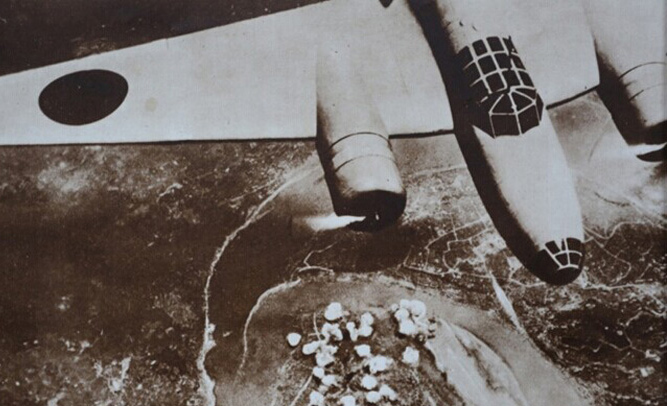Study sheds light on Bombing of Chongqing

A Japanese army aircraft bombs the Jinling Arsenal in Chongqing on June 16, 1940.
“Two children were dead in their mother’s arms. The charred bodies were hard to separate.” This was what Guo Moruo, a famous Chinese historian, wrote after experiencing the Bombing of Chongqing during China’s war of resistance against Japan. Chinese historians and scholars are still trying to explore historical information to better understand Japan’s rare level of inhuman atrocity in all the history of recorded human warfare.
From February 1938 to December 1944, Japanese invaders bombarded Chongqing Municipality, wartime capital of the Kuomintang government, the business districts of surrounding cities and the civilian areas for six years and 10 months. This became known to history as “The Bombing of Chongqing.” The bombing caused more than 32,000 direct casualties and over 6,600 indirect casualties.
Zhang Kaiyuan, a professor at Central China Normal University, is not only a researcher of the history of China’s war of resistance against Japan, but also a victim of the Bombing of Chongqing. “At the time I was living at a relative’s home on the southern bank of the Yangtze River. When the fiercest bombing took place, at the gate of the air-raid shelter, I could see the flames and smoke erupt from downtown Chongqing and that the waves in the river, stirred up by the bombing, were more than three meters high.
The memory of those bloody scenes is still fresh in my mind,” he wrote in the foreword of the Series of Archived Literature and Historical Data of the Bombing of Chongqing.
Among the ruins, there are several sites that were once embassy institutions in Chongqing. The buildings were damaged by Japanese invaders in the bombing, when the institutions had to find other places to take shelter. According to a study conducted by Feng Qinghao, a researcher at the Chongqing China Three Gorges Museum, Japanese forces seriously departed from the provisions and conventions of the relevant international treaties and unscrupulously attacked the foreign affairs agency of the third country, which constituted serious war crimes.
“The bombing of Chongqing was the most centralized and representative among the indiscriminate bombings by Japanese invaders during the war,” said Pan Xun, a professor at Southwest University, and executive deputy director at the China’s War Against Japan Rear Area Research Center in Chongqing. He has been studying the Bombing of Chongqing for many years.
Some scholars have indicated that the recent studies into this piece of wartime history lag behind other areas of historical research, despite the fact there are a lot of relevant original files and preserved documents which should aid in collating historical data for further study.
Pan said that the project will collect and sort data in a comprehensive manner, which will enhance further study into the Bombing of Chongqing. The damage caused by the bombing and its influence on China and the international community will also be analyzed, he added.
In recent years, Zhang Jin, a professor at Chongqing University, has systematically studied the reports on the bombing written by foreign news agencies in Chongqing during the war. He analyzed 187 related reports written by the New York Times from 1938 to 1943, among which the number of the direct reports of the Bombing of Chongqing represented over three fifths of the total number. And they recorded in detail the power of the Japanese air raid, the bloody bombings, the serious casualties and losses, and the relief and evacuation efforts. The scholars said that the series of reports by foreign press recorded the disaster from the perspective of objective recorders, and have thus become important historical resources to be further studied.
Zeng Jiang and Geng Xue are reporters at the Chinese Social Sciences Today.
